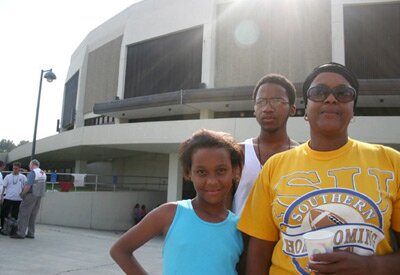At Southern U. "Minidome," Cheer Despite the Ordeal
Southern University in Baton Rouge, La., opened its doors to 500 evacuees from southeastern Louisiana and coastal Mississippi who managed to escape the wrath and aftermath of Hurricane Katrina. The evacuees included 9-year-old twins separated from their families, single men and women, and family groups, all staying at the F. G. Clark Activity Center. Some came the 150 miles from Biloxi, Miss., others 85 miles from New Orleans, still others from towns along the Louisiana and Mississippi shoreline.
Usually home to athletic events and concerts for students, the �minidome� became a shelter operated by the capital-area chapter of the American Red Cross. Evacuees washed their clothes and hung shirts, pants and socks from the railings of the ramps encircling it. Inside was a calm and orderly scene of mostly African Americans looking for fresh clothing from racks of donations, and seeking meals and toiletries from Red Cross and other volunteers. The space was divided to house families in the middle, single women on the left, single men on the right. Some were bedraggled and dirty, still wearing whatever they had on when they were rescued from the floodwaters and dropped off at the shelter by van and busload. Yet there was an atmosphere of cheer despite their ordeal. The evacuees could be seen sharing cell phones and helping each other sort clothing. And in contrast to some of the grim television images of anger and desperation, many were kindly and laughing, peppering any newcomer with questions, seeking news of their neighborhoods and homes. The public was not allowed inside, and Southern University campus police and Baton Rouge law enforcement officers manned the doors to ensure that only evacuees entered. They used markers to draw happy faces on the hands of those who needed to exit and re-enter. Children were everywhere, some dirty and obviously having been through an ordeal, others scrubbed and outfitted in donated clothes. They included the 9-year-old twins. �When the call was sent out, we did not hesitate one moment to offer our facilities as a place of refuge to the people of New Orleans,� said Southern Chancellor Edward R. Jackson. Campus sororities and fraternities and groups from the Scotlandville community, which surrounds the Southern University campus, brought clothes and food to the shelter. Jackson said the university was searching for entertainment for the children and televisions for the adults. �Being shut up in a place all day becomes boring. It is really depressing,� he said. In addition to the official shelter, the campus became an unofficial refuge for relatives of Southern students who needed to escape their homes in the flood zone, he added. There were reports that families were staying with students in the dorms. �We don�t have an official count of who they are exactly, but there have been reports of children and older people in the cafeterias,� Jackson said. �We will not kick these people out because they have nowhere to go; however, we are trying to help them find housing by Saturday," Sept. 3, "so that we can resume classes on Tuesday with some sense of normalcy.� According to Keisha LaCour, Southern University director of media relations, the school did not lose power during the storm, though there were widespread power outages and telephone and Internet communications were difficult throughout the Baton Rouge area. All students on campus were safe, she said. Southern University had opened for the school year on Aug. 22, but suspended classes on Aug. 29 as Katrina�s landfall was predicted to lash the state with high winds. Classes resumed on Sept. 6. The reopened campus was expected to take on yet another group: the staff and 3,050 students who cannot return to the Southern University New Orleans commuter campus. �We know SUNO is under water and we know the damage is devastating,� said Jackson, who is also the interim president of the Southern University system of campuses, which includes facilities in New Orleans and Shreveport. �The system is in the process of moving Southern University New Orleans� administration to the Baton Rouge campus to get their operation up and running,� said Robyn Merrick, director of public affairs for the system. �We are trying to locate these students because most either stayed (in the area) or evacuated with their families.� Administrators at the Baton Rouge main campus said they would honor the enrollments of the students on the New Orleans campus. When Katrina forced that campus to close, it was still in its registration period. Southern University New Orleans is on the south shore of Lake Pontchartrain in the Gentilly area. �The first step we are going to take is to assess the damage of the campus and help the students and administration settle in Baton Rouge,� Merrick said. An effort was under way to set up a hot line to provide assistance and get information to any Southern University New Orleans students and their families. Southern University�s planned Sept. 3 football game in Lake Charles, La., against McNeese State was called off. Jackson said, �I�m not sure of whether there will even be a football season. I can�t imagine that Southern, LSU or the Saints would play in a city where there are people who have lost everything,� referring to Louisiana State University and the NFL team. Posted Sept. 5, 2005; updated Sept. 6, 2005 |
https://blackcollegewire.org/news/050904_katrina-minidome/
|
Home | News | Sports | Culture | Voices | Images | Projects | About Us Copyright © 2006 Black College Wire. Black College Wire is a project of the Black College Communication Association and has partnerships with The National Association of Black Journalists and the Robert C. Maynard Institute for Journalism Education. |
